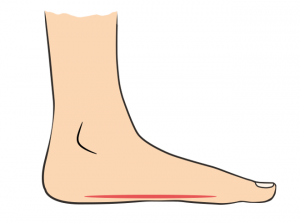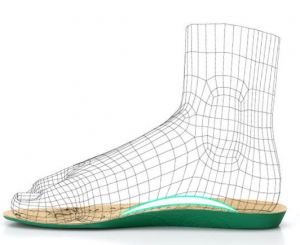What are flat feet, exactly?
In the middle of the foot, there is usually a curve or arch. There is little or no arch in flat feet. Flat feet can also be caused by arches that have fallen, flattened, or collapsed.
In and of itself, flat feet do not often imply lower body difficulties. Flat feet, on the other hand, may make you more vulnerable to a variety of lower-body problems, especially as you become older. Flat feet might become fatigued and achy over time.
Flat feet can be caused by a variety of circumstances, and while the condition can be uncomfortable, there are several ways to alleviate the pain. Simple lifestyle adjustments to medication treatments are all possible solutions.

1- Modifications to one’s lifestyle
1.Attain a healthy weight — Being overweight might lead to flat feet. If you’re overweight, losing weight can relieve strain on your feet and help you feel better.
2.Standing time is limited — Avoid standing for long amounts of time to avoid aggravating flat feet.
3.Keep it low-impact – Low-impact sports, such as swimming or cycling, are preferable to high-impact workouts like jogging, which can cause uncomfortable strain on the feet.
2- Insoles, orthotics, and shoes
1.Pick good shoes – Always wear shoes with good arch support and avoid walking or standing barefoot.
2.Use orthotics for support – Orthotic inserts can help support your arch. IDEASTEP Arch Pain Relief Orthotics are made to provide long-term relief from arch pain.
3.Insert insoles – Adding insoles to your shoes can improve their performance by providing more comfort and support for your various activities.
IDEASTEP’s® Tri-Comfort® Insoles give additional cushioning and support for the arch, heel, and ball of the foot.
Designed specifically for big and tall men, IDEASTEP® Extra Support Insoles assist distribute body weight more evenly, reducing pressure on the feet.
Consider IDEASTEP® Sport Insoles if you work out at home or at the gym, or if you participate in team sports. They aid in the absorption of shock and the reduction of foot fatigue.
3- Stretching
1.Foot flex and massage – Gently flex one foot while lightly pulling your toes back with your palms. Hold for a few seconds before massaging the bottom of your foot. Do this 5 times on both foot.
2. Ball roll — Place a tennis-sized ball under one foot and roll it back and forth for 3 minutes while seated. Do this 2 to 3 times on both feet. For heat or cold therapy, use IDEASTEP Foot Massage Ball.
4- Stamina-building workouts
1.Foot roll – While standing, roll your feet such that your weight is distributed to the outsides of your feet and your arches are lifted off the floor. Rep 10 times more.
2.Calf raise – Stand on the stairwell with your heels dangling off the edge of one of the steps. Lift your heels gently and hold for 5 seconds. Slowly return your heels to their original position. Rep 15 times more.
3.Towel grab – Place a towel underneath your feet while seated. With your toes, grab the towel and push your heels against the floor. Hold the position for 5 seconds. Rep 10 times more.

For all stretching and strengthening exercises, carefully follow the directions. Stop the exercise and notify your healthcare professional if you encounter any pain or discomfort.
5- Therapies and treatments
1.Cold therapy — Apply a cloth-covered ice pack to the bottoms of your feet for 10-20 minutes several times a day to reduce swelling.
2.NSAIDs such as ibuprofen and naproxen, which are available over-the-counter, can help relieve pain and inflammation.
3.A doctor may give corticosteroids to relieve inflammation, which causes pain and swelling.
4.Physical therapy – a physical therapist can assist you in developing an exercise program that can enhance your mobility and minimize your pain.
While many people can handle the symptoms of flat feet on their own, severe and persistent discomfort that does not improve should be addressed by a doctor.
